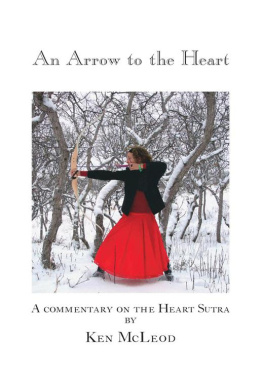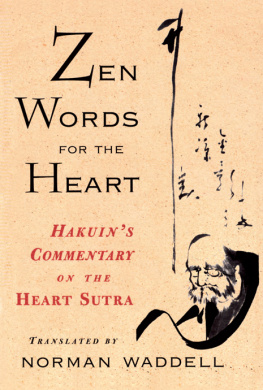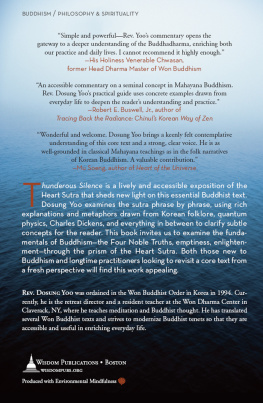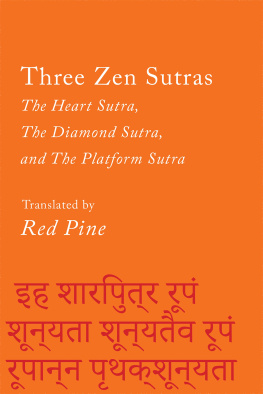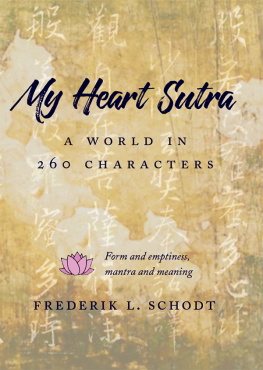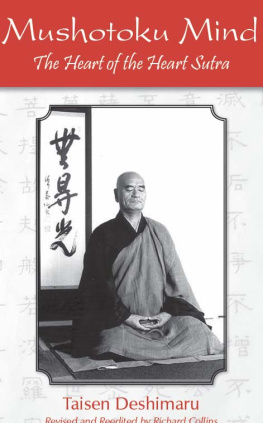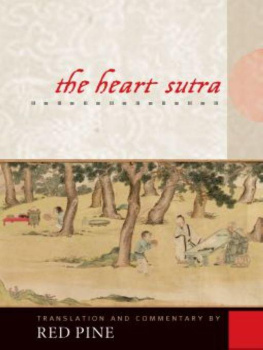An Arrow to the Heart
A COMMENTARY ON THE HEART SUTRA
BY
KEN MCLEOD

Order this book online at
Most Trafford titles are also available at major online book retailers.
Copyright 2007 Ken McLeod.
All rights reserved. No part of this publication may be reproduced, stored in a retrieval system, or transmitted, in any form or by any means, electronic, mechanical, photocopying, recording, or otherwise, without the written prior permission of the author.
Illustrations Copyright 2007 Dick Allen Book and cover design by Deborah Neikirk Photography by Jeff Bickford & Gail Gustafson Translation of the Heart Sutra by Ken McLeod
Note for Librarians: A cataloguing record for this book is available from Library and Archives Canada at www.collectionscanada.ca/amicus/index-e.html
Printed in Victoria, BC, Canada.
ISBN: 978-1-4251-3377-1
We at Trafford believe that it is the responsibility of us all, as both individuals and corporations, to make choices that are environmentally and socially sound. You, in turn, are supporting this responsible conduct each time you purchase a Trafford book, or make use of our publishing services. To find out how you are helping, please visit www.trafford.com/responsiblepublishing.html
Our mission is to efficiently pro-vide the worlds finest, most comprehensive book publishing service, enabling every author to experience success. To find out how to publish your book, your way, and have it available worldwide, visit us online at www.trafford.com/10510

www.trafford.com
North America & international
toll-free: 1 888 232 4444 (USA & Canada) phone: 250 383 6864 fax: 250 383 6804 email:
The United Kingdom & Europe
phone: +44 (0)1865 722 113 local rate: 0845 230 9601 facsimile: +44 (0)1865 722 868 email:
10 9 8 7 6 5 4 3 2
Contents
Numerous individuals played crucial roles in bringing this book to its present formYvonne Rands consistent encouragement, the keen editorial eye of Janaki symon and the helpful contributions of Ann Braun, Richard Collins, Lynea Diaz-Hagan, George Draffan, Claudia Hansson, Carolyn Hudson, Scott Lawrance, Sandy Pollock, Ajahn Thanasanti, Jeff Tip, and others. Dick Allen generously provided commentary in the form of the illustrations that complement the text. And Im grateful to Deborah Neikirk for designing the book and shepherding it through the publication process.
This commentary itself builds on the work of other teachers and scholars, notably Hakuin, Red Pine, and Stephen Batchelor.
Most influential, perhaps, is Hakuins Zen Words for the Heart, a commentary from another age and another culture17th century Japanese Zen. No doubt sitting on a pile of wordy and philosophical commentaries, Hakuin took up a sword and slashedthere really is no other word for itthrough all conceptual thinking. His combination of prose and poetry cuts away everything and leaves the reader with nothing but the awake knowing the sutra presents.
Red Pines commentary, The Heart Sutra: the Womb of Buddhas, truly shows what depth of scholarship combined with sensitivity to practice can do to illuminate the meaning of a text and to make the subtleties of the teaching accessible.
In Verses From the Center Stephen Batchelor interprets Nagarjunas verses as a precise investigation of experience through the lens of questioning attention. In doing so, Stephen opened the door for other western teachers to give experiential, rather than academic, interpretations of classical texts.
I was able to write this book only because of the continued support and encouragement from students here in Los Angeles and elsewhere. To all of them I am humbly grateful.
Ken McLeod Los Angeles, 2007
Form is emptiness.
Emptiness is form.
Emptiness is not other than form.
Form is not other than emptiness.
For centuries these four sentences have echoed down the corridors of time. The echoes continue today, wherever the Heart Sutra is recited, in Tibetan and Mongolian monasteries, chinese, Japanese and Korean temples, and, now, in monasteries, temples, and centers all through Europe and North and South America.
clearly, the Heart Sutra is not a devotional work, though it is an object of devotion for many. You find no exhortations to piety, no articles of faith, no inspirational imagery. Nor is it an ethical statement, for it is free from any moral injunctions or guidelines for behavior. If you are looking for the authority of Buddha, you find he says only a single sentence of confirmationnothing else. It is not a meditation guide, at least, not a very good one, for the few instructions are abstruse and inaccessible. For many people, their first impression is one of overwhelming negation: no this, no that, no that, no this, down, down, down a long list of puzzling terms.
Why, then, is this short text held in such high regard?
The Heart Sutra is about the perfection of wisdoman understanding of life and being that is experiential, not conceptual or intellectual. Just as a description of the taste of a cherry pie provides nothing to satisfy hunger and little to enjoy, a conceptual understanding of the perfection of wisdom does little to change how we actually understand life and live it. As a verse in praise of the perfection of wisdom says:
Perfection of Wisdom, inexpressible, inconceivable, indescribable, Without beginning or end, like the sky itself, The experience of pristine awareness, knowing itself. To the mother of the buddhas of the three times, I bow.
Read the four lines about form and emptiness again, slowlyor say them, slowly. What happens? For a moment, or perhaps a little longer, the incessant cacophony of thoughts, memories, and associations in your head stops. Even the echoes stop. Granted, if you are encountering these words for the first time, that gap probably lasts only a moment and is usually followed by a Huh? But your mind does stop. What do you experience, right there? That experience, and what follows from it, is what the Heart Sutra is pointing to.
Defying all logic, these four lines reveal a different way of experiencing life, a way in which the usual dualities are not opposites, but complementary expressions of a deeper knowing. That deeper knowing is the subject of the Heart Sutra. A commentary to the sutra aims to help the reader or student come closer to that knowing.
Traditionally, teachers in each generation offer their own commentaries to their students, commentaries that bring out points in the texts that are relevant for their time and culture. While hundreds of Asian commentaries have been written on the Heart Sutra, commentaries by western teachers are only now beginning to appear.
In contrast to most commentaries, I approach the Heart Sutra not as a philosophical exposition of emptiness, but as the presentation of a moment of being completely awake and present. Any attempt to explain such an experience is pointless and futile. It is beyond explanation. Accordingly, the aim of this commentary is not to explain this experience to you, but to elicit it in you.
on each page, you will find a poetic riff that may evoke an insight or a question, a prose riff that often includes questions for you to consider, and notes that provide information on the technical terms and references sprinkled throughout the text. The commentary proceeds line by line, phrase by phrase, eschewing any attempt to explain the structure or progression of the dialectic.
The commentary is not quite as arbitrary as it may seem. In some sections, I based the poetic and prose riffs on classical exegeses. As an example, consider the line:
Next page
